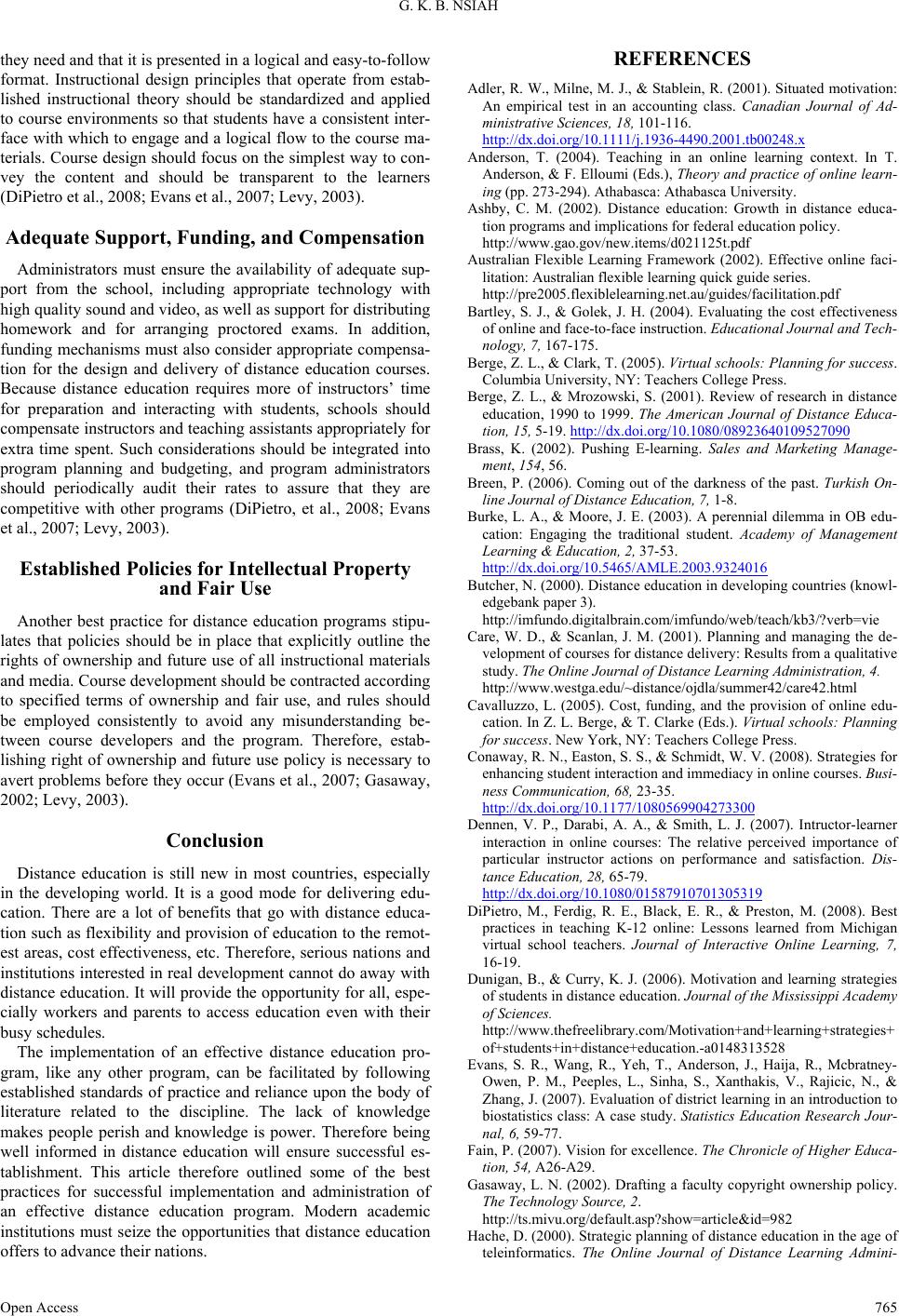
G. K. B. NSIAH
Open Access 765
they need and that it is presented in a logical and easy-to-follow
format. Instructional design principles that operate from estab-
lished instructional theory should be standardized and applied
to course environments so that students have a consistent inter-
face with which to engage and a logical flow to the course ma-
terials. Course design should focus on the simplest way to con-
vey the content and should be transparent to the learners
(DiPietro et al., 2008; Evans et al., 2007; Levy, 2003).
Adequate Support, Funding, and Compensation
Administrators must ensure the availability of adequate sup-
port from the school, including appropriate technology with
high quality sound and video, as well as support for distributing
homework and for arranging proctored exams. In addition,
funding mechanisms must also consider appropriate compensa-
tion for the design and delivery of distance education courses.
Because distance education requires more of instructors’ time
for preparation and interacting with students, schools should
compensate instructors and teaching assistants appropriately for
extra time spent. Such considerations should be integrated into
program planning and budgeting, and program administrators
should periodically audit their rates to assure that they are
competitive with other programs (DiPietro, et al., 2008; Evans
et al., 2007; Levy, 2003).
Established Policies for Intellectual Property
and Fair Use
Another best practice for distance education programs stipu-
lates that policies should be in place that explicitly outline the
rights of ownership and future use of all instructional materials
and media. Course development should be contracted according
to specified terms of ownership and fair use, and rules should
be employed consistently to avoid any misunderstanding be-
tween course developers and the program. Therefore, estab-
lishing right of ownership and future use policy is necessary to
avert problems before they occur (Evans et al., 2007; Gasaway,
2002; Levy, 2003).
Conclusion
Distance education is still new in most countries, especially
in the developing world. It is a good mode for delivering edu-
cation. There are a lot of benefits that go with distance educa-
tion such as flexibility and provision of education to the remot-
est areas, cost effectiveness, etc. Therefore, serious nations and
institutions interested in real development cannot do away with
distance education. It will provide the opportunity for all, espe-
cially workers and parents to access education even with their
busy schedules.
The implementation of an effective distance education pro-
gram, like any other program, can be facilitated by following
established standards of practice and reliance upon the body of
literature related to the discipline. The lack of knowledge
makes people perish and knowledge is power. Therefore being
well informed in distance education will ensure successful es-
tablishment. This article therefore outlined some of the best
practices for successful implementation and administration of
an effective distance education program. Modern academic
institutions must seize the opportunities that distance education
offers to advance their nations.
REFERENCES
Adler, R. W., Milne, M. J., & Stablein, R. (2001). Situated motivation:
An empirical test in an accounting class. Canadian Journal of Ad-
ministrative Sciences, 18, 101-116.
http://dx.doi.org/10.1111/j.1936-4490.2001.tb00248.x
Anderson, T. (2004). Teaching in an online learning context. In T.
Anderson, & F. Elloumi (Eds.), Theory and practice of online learn-
ing (pp. 273-294). Athabasca: Athabasca University.
Ashby, C. M. (2002). Distance education: Growth in distance educa-
tion programs and implications for federal education policy.
http://www.gao.gov/new.items/d021125t.pdf
Australian Flexible Learning Framework (2002). Effective online faci-
litation: Australian flexible learning quick guide series.
http://pre2005.flexiblelearning.net.au/guides/facilitation.pdf
Bartley, S. J., & Golek, J. H. (2004). Evaluating the cost effectiveness
of online and face-to-face instruction. Educational Journal and Tech-
nology, 7, 167-175.
Berge, Z. L., & Clark, T. (2005). Virtual schools: Planning for success.
Columbia University, NY: Teachers College Press.
Berge, Z. L., & Mrozowski, S. (2001). Review of research in distance
education, 1990 to 1999. The American Journal of Distance Educa-
tion, 15, 5-19. http://dx.doi.org/10.1080/08923640109527090
Brass, K. (2002). Pushing E-learning. Sales and Marketing Manage-
ment, 154, 56.
Breen, P. (2006). Coming out of the darkness of the past. Turkish On-
line Journal of Distance Education, 7, 1-8.
Burke, L. A., & Moore, J. E. (2003). A perennial dilemma in OB edu-
cation: Engaging the traditional student. Academy of Management
Learning & Education, 2, 37-53.
http://dx.doi.org/10.5465/AMLE.2003.9324016
Butcher, N. (2000). Distance education in developing countries (knowl-
edgebank paper 3).
http://imfundo.digitalbrain.com/imfundo/web/teach/kb3/?verb=vie
Care, W. D., & Scanlan, J. M. (2001). Planning and managing the de-
velopment of courses for distance delivery: Results from a qualitative
study. The Online Journal of Distanc e Learning Administration, 4 .
http://www.westga.edu/~distance/ojdla/summer42/care42.html
Cavalluzzo, L. (2005). Cost, funding, and the provision of online edu-
cation. In Z. L. Berge, & T. Clarke (Eds.). Virtual schools: Planning
for success. New York, NY: Teachers College Press.
Conaway, R. N., Easton, S. S., & Schmidt, W. V. (2008). Strategies for
enhancing student interaction and immediacy in online courses. Busi-
ness Communication, 6 8, 23-35.
http://dx.doi.org/10.1177/1080569904273300
Dennen, V. P., Darabi, A. A., & Smith, L. J. (2007). Intructor-learner
interaction in online courses: The relative perceived importance of
particular instructor actions on performance and satisfaction. Dis-
tance Education, 28, 65-79.
http://dx.doi.org/10.1080/01587910701305319
DiPietro, M., Ferdig, R. E., Black, E. R., & Preston, M. (2008). Best
practices in teaching K-12 online: Lessons learned from Michigan
virtual school teachers. Journal of Interactive Online Learning, 7,
16-19.
Dunigan, B., & Curry, K. J. (2006). Motivation and learning strategies
of students in distance education. Journal of the Mississippi Academy
of Sciences.
http://www.thefreelibrary.com/Motivation+and+learning+strategies+
of+students+in+distance+education.-a0148313528
Evans, S. R., Wang, R., Yeh, T., Anderson, J., Haija, R., Mcbratney-
Owen, P. M., Peeples, L., Sinha, S., Xanthakis, V., Rajicic, N., &
Zhang, J. (2007). Evaluation of district learning in an introduction to
biostatistics class: A case study. Statistics Education Research Jour-
nal, 6, 59-77.
Fain, P. (2007). Vision for excellence. The Chronicle of Higher Educa-
tion, 54, A26-A29.
Gasaway, L. N. (2002). Drafting a faculty copyright ownership policy.
The Technology So urce, 2.
http://ts.mivu.org/default.asp?show=article&id=982
Hache, D. (2000). Strategic planning of distance education in the age of
teleinformatics. The Online Journal of Distance Learning Admini-